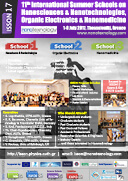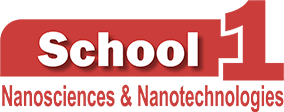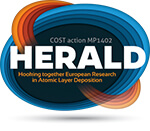NANOTEXNOLOGY Plenary Speakers
 | Prof. Seth Marder, Georgia Tech IEN, USA The Use of Dopants to Modulate the Properties of Organic Semiconductors, 2D Materials and Electrodes |
 | Prof. John Seiradakis, Aristotle University of Thessaloniki, Greece The Antikythera Mechanism: Decoding an astonishing 2nd century BCE astronomical computer |
 | Prof. Henry J. Snaith, University of Oxford, UK Metal halide perovskites: a new class of semiconductors for photovoltaic and optoelectronic devices |
ISSON17 Lecturers
 | Prof. Ioannis Bakouros, University of Western Macedonia, Greece The European Startups as Innovation Drivers and Job Engines. The case of Nanotechnology based Firms |
 | Prof. Fabio Biscarini, Department of Life Sciences, University of Modena and Reggio Emilia, Italy Organic Bioelectronics |
 | Dr. Ilise Feitshans, Institute for Work and Health University of Lausanne, Switzerland Ten Years After: Ethical Legal And Social Impacts Of Emerging Nanotechnology Laws |
 | Prof. Stergios Logothetidis, LTFN, AUTh, Greece Nanotechnology and Applications |
 | Dr. Raul Arenal, University of Zaragoza, Spain EELS in a TEM |
 | Dr. Fabio Caruso, Humboldt University of Berlin, Germany Spectroscopy from first-principles: an introduction to many-body perturbation theory |
 | Dr. Tim Echtermeyer, The University of Manchester, UK Graphene for electronic and optical applications |
 | Dr. Antonio Lombardo, Cambridge Graphene Center, University of Cambridge, UK Graphene Electronics |
 | Prof. Sivakumar Manickam, University of Nottingham Malaysia Campus, Malaysia A Cleaner, Greener and Sustainable Cavitation Technology for the Generation of Nanomaterials and Nanoformulations |
 | Prof. Kyriakos Porfyrakis, University of Oxford, UK Carbon Nanomaterials: Synthesis, Properties and Applications |
 | Prof. Helmut Schmid, Fraunhofer-Institue for Chemical Technology (ICT), Germany Development and Successful Launch of Nanotechnological Products |
 | Dr. Mariano Campoy, Institute of Materials Science of Barcelona (ICMAB-CSIC), Spain Organic ThermoElectrics |
 | Dr. Thomas Marszalek, Max Planck Institute for Polymer Research, Germany Role of polymer backbone organization on charge carrier transport |
 | Prof. Martyn Pemble, Chemistry and Tyndall National Institute, University College Cork, Ireland An introduction to Colloidal Photonic Crystals and their Applications |
 | Dr. Antigoni Alexandrou, Laboratory for Optics & Biosciences, Ecole Polytechnique, France Nanosensors for measuring cell parameters |
 | Prof. Perena Gouma, Department of Materials Science and Engineering, University of Texas at Arlington, USA High-Throughput Electrospinning of Hybrid Nanocomposites |
 | Dr. Varvara Karagkiozaki, LTFN, AUTh, Greece Basic Principles in Nanomedicine |
 | Prof. Yannis Missirlis, Lab of Biomechanics & Biomedical Engineering, University of Patras, Greece Introduction to Bioreactors for Tissue Engineering |
 | Prof. Thimios Mitsiadis, University of Zurich, Switzerland New approaches for dental treatments: the “stem cell/nanotechnology” amalgam |
 | Prof. Giovanna Orsini, Università Politecnica delle Marche, Italy Strategies for dental tissues repair and regeneration |




























